Uncovering the birthplaces of stars in the Milky Way

Birthplaces of 600 stars situated very close to the Sun. I. Minchev (AIP)
Stars in galactic discs have long been known to wander away from their birth sites owing to a phenomenon known as “radial migration”. This movement across the Galaxy severely hampers inferences of the Milky Way formation history.
Radial migration is influenced by a number of parameters that are still poorly known: for example, the size and speed of the Galactic bar, the number and shape of spiral arms in the Galactic disc, and the frequency of smaller galaxies colliding with the Milky Way during the past 10 billion years and their respective masses.
To circumvent these obstacles, the scientists devised a way of recovering the Galactic migration history using the ages and chemical composition of stars as “Archaeological artifacts”. They used the well-established fact that star formation in the Galactic disc progresses gradually outwards, following that stars born at a given position at a particular time have a distinct chemical-abundance pattern.
Therefore, if the age and chemical composition (its iron content, for example) of a star can be measured very precisely, it becomes possible to directly infer its birth position in the Galactic disc without additional modeling assumptions.
The team used a sample of about 600 solar-neighborhood stars observed with the high-resolution spectrograph HARPS mounted on the 3.6 m telescope of ESO’s La Silla Observatory in Chile. Thanks to the very precise age and iron abundance measurements, it was found that these stars were born all across the Galactic disc, with older ones coming more from the central parts.
Researches can now use this method for calculation of birth places even for stars not in the original sample. For example, given the age of our Sun of 4.6 billion years and its iron content, it could be estimated that the Sun was born about 2,000 light years closer to the Galactic center than it is currently located.
Minchev comments: “Once in the possession of birth radii, a wealth of invaluable information could be gained about the Milky Way past, even from this small number of stars with precise enough measurements available to us at this time.”
Co-author Friedrich Anders adds: “In the near future, applying this method to the extremely high-quality data from the Gaia mission and ground-based spectroscopic surveys will allow much more exact measurements of the migration history and, thus, the Milky Way past.”
The key areas of research at the Leibniz Institute for Astrophysics Potsdam (AIP) are cosmic magnetic fields and extragalactic astrophysics. A considerable part of the institute's efforts aim at the development of research technology in the fields of spectroscopy, robotic telescopes, and e-science.
The AIP is the successor of the Berlin Observatory founded in 1700 and of the Astrophysical Observatory of Potsdam founded in 1874. The latter was the world's first observatory to emphasize explicitly the research area of astrophysics. The AIP has been a member of the Leibniz Association since 1992.
Ivan Minchev, 0331-7499-259, iminchev@aip.de
Media Contact
All latest news from the category: Physics and Astronomy
This area deals with the fundamental laws and building blocks of nature and how they interact, the properties and the behavior of matter, and research into space and time and their structures.
innovations-report provides in-depth reports and articles on subjects such as astrophysics, laser technologies, nuclear, quantum, particle and solid-state physics, nanotechnologies, planetary research and findings (Mars, Venus) and developments related to the Hubble Telescope.
Newest articles
Faster, more energy-efficient way to manufacture an industrially important chemical
Zirconium combined with silicon nitride enhances the conversion of propane — present in natural gas — needed to create in-demand plastic, polypropylene. Polypropylene is a common type of plastic found…

Energy planning in Ghana as a role model for the world
Improving the resilience of energy systems in the Global South. What criteria should we use to better plan for resilient energy systems? How do socio-economic, technical and climate change related…

Artificial blood vessels could improve heart bypass outcomes
Artificial blood vessels could improve heart bypass outcomes. 3D-printed blood vessels, which closely mimic the properties of human veins, could transform the treatment of cardiovascular diseases. Strong, flexible, gel-like tubes…





















